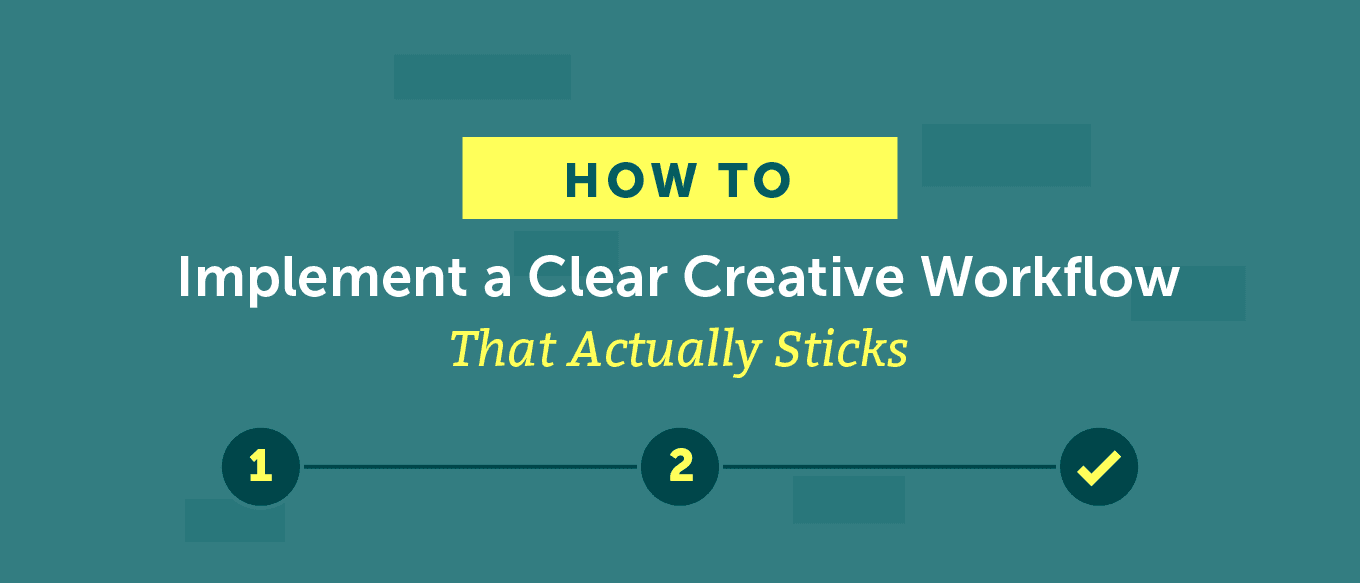
Marketing creatives often
avoid process and workflow planning at all costs. For them, those things aren’t what make their work interesting. They might even think they inhibit
creativity or belong only in stuffy “corporate” environments.
Those things aren’t all true, of course.
In fact, taking a skeptical approach toward planning and process can actually make your work more difficult and less effective, rather than the other way around.
That doesn’t mean that developing workflows that actually work for creative marketers is without challenges. Nor does it mean that skepticism is completely unfounded (we’ve all been in situations where processes were more burdensome and functional).
So, how do you balance the need to provide structure for your projects, without bogging your team down with unnecessary red tape? That's what this post will answer.
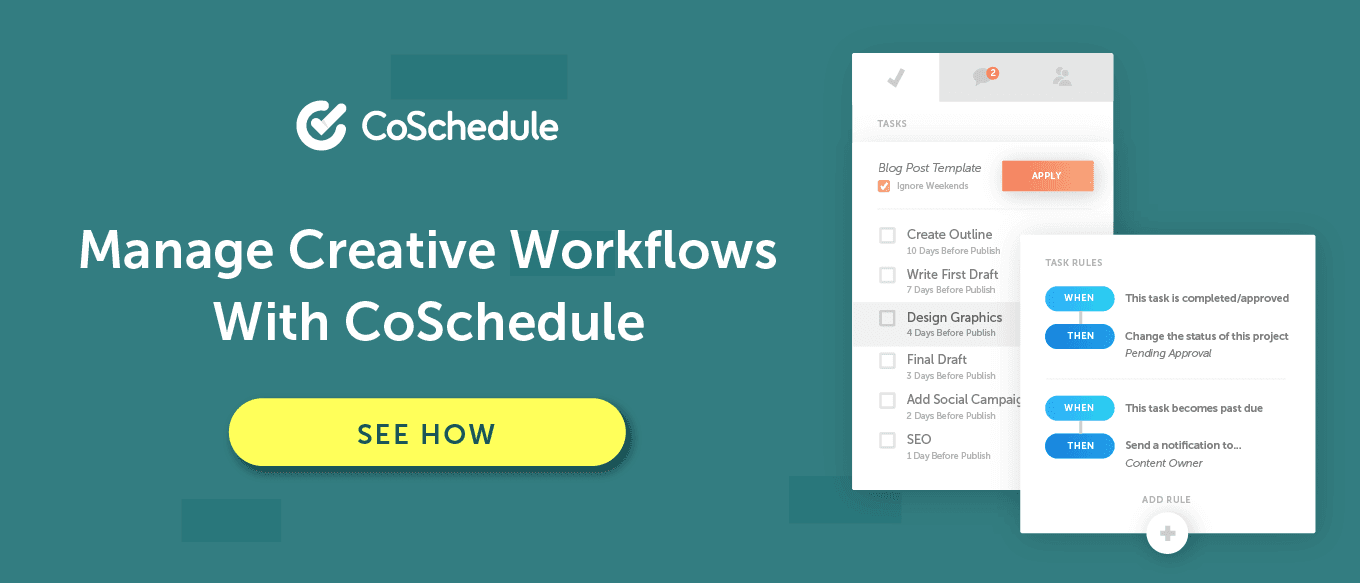
Creative Marketing Workflow Template
Planning out processes and visualizing workflows is easier when you have some basic tools to complete these jobs. Grab the following bundle below and get:
- Time Tracking Template: For understanding exactly how long tasks take.
- Workflow Checklist Template: For planning and managing workflows.
- Marketing Calendar Template: For visualizing project deadlines.
Download all three now, then follow the steps laid out through the rest of this post.
Common Workflow Objections (And How to Overcome Them)
Creatives often don’t want to be told what they should do. At least, not if they can’t clearly see the value in your request.
So, when discussions come up around changing or adding processes, there are some common objections you’re likely to hear. None of them necessarily hold up under much scrutiny, but they (mostly) come from a place of genuine concern for possible negative impacts.
Here are some things you can expect to hear (and how to counter them).
“Process Inhibits Creativity”
Ever walk by a designer’s desk and find it to be a mess?
If so, that person will probably tell you they work better that way, and that trying to structure their workdays too much will stop them from producing creative ideas as easily.
They might feel that way. But is that actually true?
Probably not.
Take the following quote from
1800s French author Gustave Flaubert:
Be regular and orderly in your life, so that you may be violent and original in your work.
Now, Flaubert (probably) didn’t literally mean your work should be violent in a combative sense, so much as disruptively creative and threatening to the status quo.
The reasoning? Being organized helps deliver better creative work by making you mentally free to focus on the task at hand. In fact, data from a
recent CoSchedule survey bears this out, finding that organized marketers are 397% more likely to report success.
Creatives may not always like math, but the numbers don’t lie.
“That New Process Will Never Stick”
Habits are hard to break.
That’s what makes them habits in the first place.
Fortunately, while bad habits are hard to ditch, that also means positive habits are easy to follow once they become automatic.
Getting to that point without letting naysaying derail your efforts is the challenge.
Here are some points and statistics that can help refute this lazy thinking:
- It takes around 66 days (on average) for a habit to stick. If you can make it that far, you’ll be likely to succeed.
- Breaking a habit takes about the same amount of time. Again, it’s not true that a new process can’t stick, or that an old one can’t be broken. It just takes the small matters of will and discipline (and if it’s shown someone objecting is just being lazy, then it makes that objection look much less strong).
- Habits are shown to be formed by doing. And creatives are doers. No one can know that the new process won’t stick without trying.

If the team can’t at least try, then their objections have little ground to stand on.
“New Workflows Will Just Get in the Way”
Sure, for any new process to stick, it needs to be unobtrusive and easy to follow.
But, if you’re currently passing files back and forth any old how, with no defined process to abide by, then how exactly is that unobtrusive or easy to follow?
Debunking this one is as simple as pointing out the obvious brokenness of this state of affairs. If you can find a specific example of this lack of actual workflow causing a problem (that shouldn’t be hard), then you’ll have something concrete to point to as well.
First, Identify Roles and Responsibilities For Your Team
Job titles are clear and obvious enough, right?
Sure, they are. But, they don’t always cover all the informal responsibilities team members might take on within a marketing department.
So, it’s useful to understand at a high level what everyone on the team actually does and where they fit into the bigger picture. This helps ensure that the right people are put on the right projects at the right time.
If you’re unsure what roles people actually fill (formally or informally) on the team, then ask (and if you’re a team lead, you should be well aware of those roles already).
What matters is simply understanding what people can do or actually do, whether within or beyond the constraints of a job description. When a project is kicked off with a creative brief (more on this in a moment), this will give you a clear idea of who needs to be on the project, and which role they should fill.
Determine a Process For Projects to Move Through From Start to Finish
Whether you’re at an agency or working within a client-side in-house team, you’ll need an agreed-upon means of moving projects from the ideation phase all the way to completion.
This doesn’t necessarily need to be complicated. There simply needs to be a consistent order of operations when it comes to generating projects and the steps they should follow.
That order will differ if you’re a freelancer, agency, or in-house marketer/creative. Here are some basic examples of what this might look like in each scenario.
Freelancer Creative Workflow
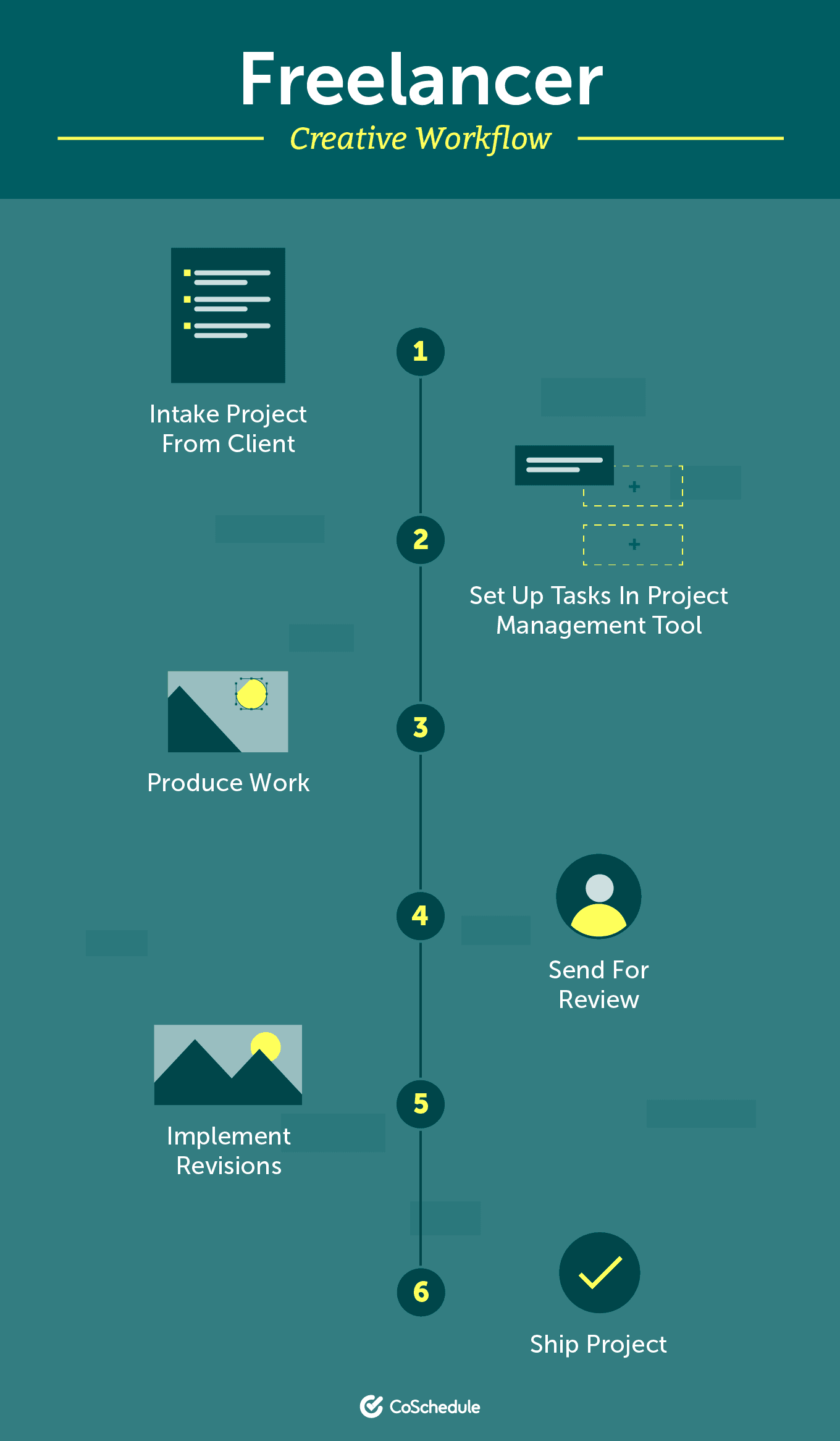
Agency Creative Workflow
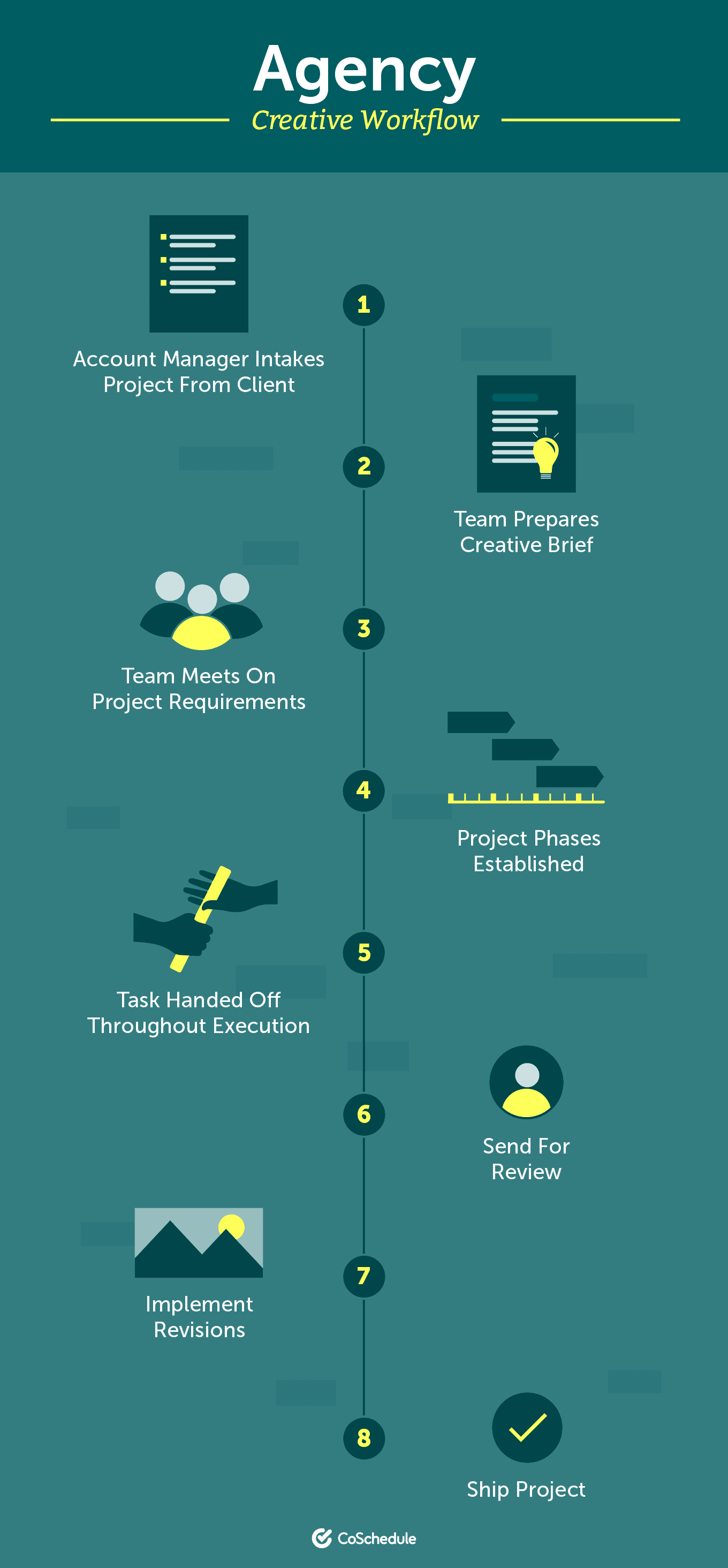
In-House Marketing Workflow
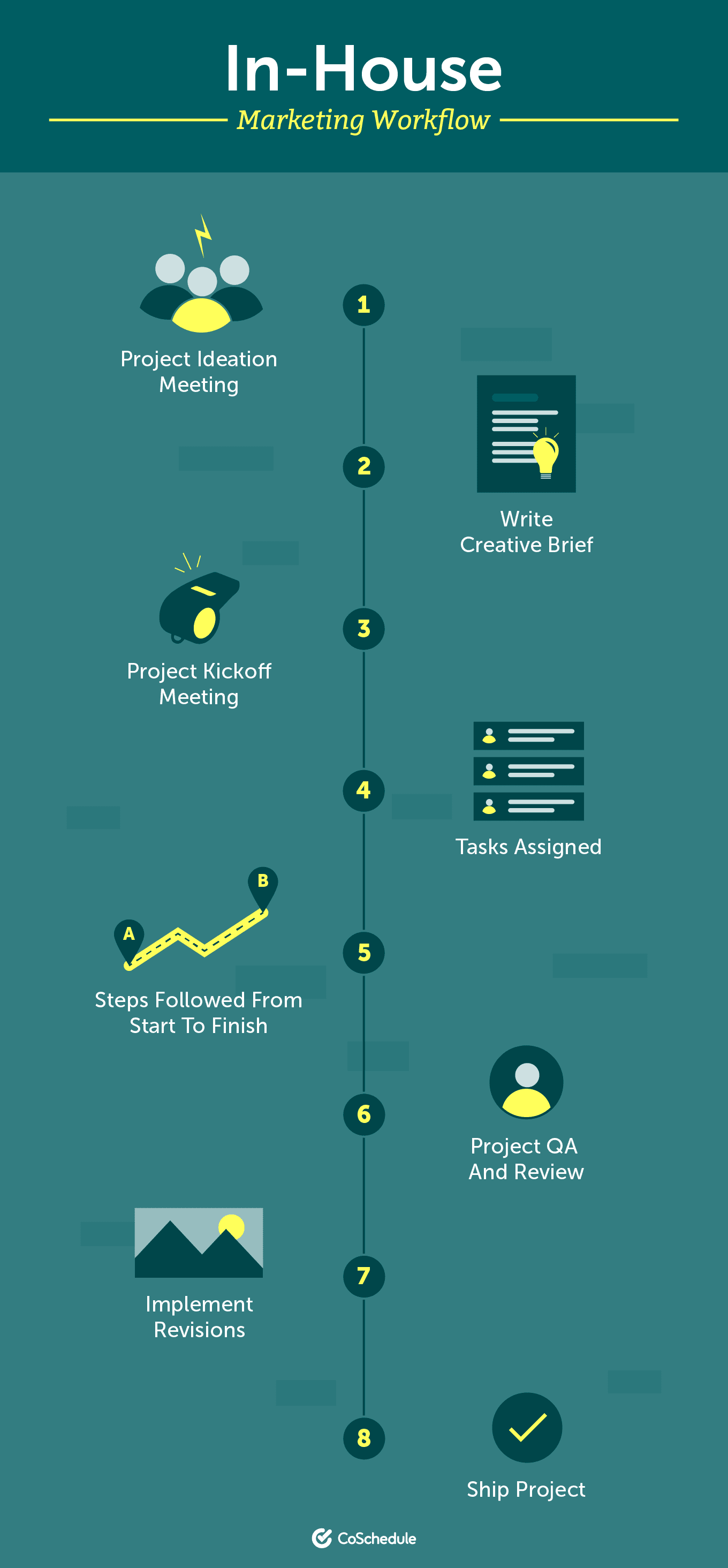
Use a Creative Brief Template for Every Project
Kicking off projects with a brief is an easy and time-tested way to document project requirements. They help everyone on the team (literally) get on the same page.
A basic brief should include:
- A project summary.
- Who’s included on the project.
- Goals, KPIs, and measurement strategy.
- Technical requirements.
- The steps or process necessary to complete the project.
- Timelines and deadlines.
Writing them well is a craft unto itself, but this summarizes about as much information as they need to include in order to be useful yet succinct.
Have a Process for Estimating Time
To make sure your workflow is effective, you’ll need to hit all your deadlines for each task throughout the project.
But, to do that, you’ll need to know how to accurately estimate the time each step will take.
That’s easier said than done.
One way to get better at estimating time is to actually track how long tasks take over time. Start by using a time-tracker like Toggl (free/paid tool with desktop, web, and mobile apps) and measure how long a particular task takes.
Start by clicking the arrow to track your time when you start a task:

Then, stop timing when you’ve finally completed the task. Simple enough, right? You can then either track your time manually using this time-tracking spreadsheet (included in the template bundle near the beginning of this post), or using automated reporting in Toggl.

If you choose to use the spreadsheet, you’ll see rows and columns for days of the week, project names, and the number of hours spent on those projects. Round your time to the nearest quarter-hour (for example, 1.25 hours). Over time, this will help you understand how long you’re trending on certain tasks and projects, so you can develop data-backed estimates.
Map Out Tasks for Projects Before Starting
Before kicking off the project, list out all the tasks required for each piece. This will help the team develop a clear workflow that everyone can follow.
Start by determining which steps need to be completed to create or finish something. For a hypothetical example, say that something is an email newsletter.
Some tasks this might require could include:
- Determining the purpose and content or messaging to include in the email.
- Writing subject line options.
- Writing email body copy.
- Writing a call-to-action.
- Designing in-line email graphics.
- Placing and testing email links.
- QA and review.
- Staging and scheduling the email.
Each of these tasks has a time estimate attached to it (and in some cases, like each of the three writing tasks, those estimates can and should be bundled together into one estimate).
Knowing that estimate (and the order the steps go in) will help you plot out the deadlines for each step.
CoSchedule customers can do this using Tasks and Task Templates. These make it possible to plan out and automate checklist-based workflows.
In this example, create a piece of email content on the
marketing calendar:

Then, on the right, either add the individual tasks required or use Task Templates to apply a list of tasks, team members, and deadlines automatically:

Once applied, you’ll have the steps in your project’s workflow clearly set up:

If you need to add approval steps for review purposes into your workflow, you can do that easily as well:

Best of all, if you use Task Templates, you can reapply the workflow in just a couple clicks on as many projects as you ever need in the future.
Many other task management, project management, and work management tools include similar functionality. Use what you have or which works best for your team.
Put a Clear Process in Place for Task Handoffs
How should team members be notified when their tasks are ready for them?
Email and chat apps (like Slack) are two options here. You can simply let them know the project is ready to be handed off, right?
Sure, but when you’re juggling project communication between multiple tools (like Slack, email, and so forth) it can be easy for things to fall through the cracks. That includes notifications that a project is ready for the next team member to start working on the next step.
If you’re using CoSchedule, your teammates can be notified of their tasks using either email or browser notifications:

You can also see your current, pending, and overdue tasks using the dashboard in CoSchedule:

As long as your tasks are set up correctly, there’s nothing else you need to do here.
What’s Your Review Process Like?
Creatives sometimes resent review processes.
Nobody loves having their work critiqued and sent back for revisions (though in order to improve, learning to love that process can be powerful for growth).
So, how can you make this process less onerous and more positive? Present it as an opportunity to sharpen their skills, rather than a torturous evisceration of their output (which it rarely ever is in actuality, but for some, that’s what it might feel like).
Whether you’re reviewing copy, design, development, or another creative task, the goal should always be to make the work better.
Google Docs and Office 365 both make it easy to manage revisions with their commenting and suggestive editing features. This makes it simple to make it clear not only what needs to be changed, but why.
Using Google Docs, set your editing status to Suggesting mode:

Then changes you make will give the recipient the option to accept or decline your edits. While you’re making changes, be sure to add comments too to provide context for why you’re making certain suggestions:

Explaining why you’re making a change is key. Here’s a quick example of a piece of feedback you might leave on an email (to go back to that hypothetical):
“This sentence is accurate, but it needs to be changed because the client prefers to use another term.”
Here’s another example:
“Your word choice here is okay, but replacing it with a stronger adjective would improve this section by increasing the urgency of the offer.”
In each example, there isn’t just a command to change something; there’s also a clear rationale for why that suggestion is being made. This helps make it clear how that feedback is improving the work.
Using
CoSchedule, it’s also easy to exchange feedback using
Discussion Threads:

And
setting up approval steps in your Task Templates also makes it easy to manage review processes.

Keep the whole process positive and simple and things will go smoothly.
Delivering Creative Projects to Clients
If you’re working in-house, all that’s left to do is ship your project and see what it can do out in the real world.
For those working as freelancers, consultants, or in agencies, you’ll need to deliver the work to a client for final approval.
Sometimes this is an awesome process. You send it off, they have no changes, and maybe they’ll even send some kind words your way.
More often though, there will be something that needs editing or rework. That isn’t always a big deal (in fact, it’s normal), but sometimes creatives can balk at what they’re asked to change (sometimes rightfully and sometimes not).
So, how can you make this easier?
For agencies, deliverables (the actual files or work you’ve created for the client) gets delivered by an account manager who mediates that relationship between the client and the agency.
Some ways to make these handoffs seamless include:
- Use a clear and consistent file naming convention. This makes it easier to avoid sending the wrong version of a file.
- Make it easy to pass feedback along. Again, using inline editing and comments is the way to go.
- If at all possible, open lines of communication between creators and client stakeholders. Sometimes this isn’t possible, but if it is, it can make things much easier than trying to mediate that conversation through an account manager. Worse yet, locking down communication completely can be disastrous (speaking from personal experience at a past position, it’s no fun at all when you’re trying to work off of incomplete wireframes designed by someone you’re not allowed to speak with--I’m not bitter, though).
Keep the process consistent and make it easy to pass along feedback. Following those two points can go a long way toward keeping your creative workflows easy and effective.
Keep Your Creative Work Flowing
Keeping your workflows and processes clear, simple, and repeatable is key to making them stick. Commit to following the steps in this post, and you’ll be able to bring order to chaos and feel at least a little bit less like you’re running around with your hair on fire (unless your hair is literally on fire, in which case, there’s little this or any blog post can do to help).
On that note, best of luck getting your team on board. Here’s to doing your best creative work.

 Marketing creatives often avoid process and workflow planning at all costs. For them, those things aren’t what make their work interesting. They might even think they inhibit creativity or belong only in stuffy “corporate” environments.
Those things aren’t all true, of course.
In fact, taking a skeptical approach toward planning and process can actually make your work more difficult and less effective, rather than the other way around.
That doesn’t mean that developing workflows that actually work for creative marketers is without challenges. Nor does it mean that skepticism is completely unfounded (we’ve all been in situations where processes were more burdensome and functional).
So, how do you balance the need to provide structure for your projects, without bogging your team down with unnecessary red tape? That's what this post will answer.
Marketing creatives often avoid process and workflow planning at all costs. For them, those things aren’t what make their work interesting. They might even think they inhibit creativity or belong only in stuffy “corporate” environments.
Those things aren’t all true, of course.
In fact, taking a skeptical approach toward planning and process can actually make your work more difficult and less effective, rather than the other way around.
That doesn’t mean that developing workflows that actually work for creative marketers is without challenges. Nor does it mean that skepticism is completely unfounded (we’ve all been in situations where processes were more burdensome and functional).
So, how do you balance the need to provide structure for your projects, without bogging your team down with unnecessary red tape? That's what this post will answer.

 If the team can’t at least try, then their objections have little ground to stand on.
If the team can’t at least try, then their objections have little ground to stand on.



 Then, stop timing when you’ve finally completed the task. Simple enough, right? You can then either track your time manually using this time-tracking spreadsheet (included in the template bundle near the beginning of this post), or using automated reporting in Toggl.
Then, stop timing when you’ve finally completed the task. Simple enough, right? You can then either track your time manually using this time-tracking spreadsheet (included in the template bundle near the beginning of this post), or using automated reporting in Toggl.
 Then, on the right, either add the individual tasks required or use Task Templates to apply a list of tasks, team members, and deadlines automatically:
Then, on the right, either add the individual tasks required or use Task Templates to apply a list of tasks, team members, and deadlines automatically:
 Once applied, you’ll have the steps in your project’s workflow clearly set up:
Once applied, you’ll have the steps in your project’s workflow clearly set up:
 If you need to add approval steps for review purposes into your workflow, you can do that easily as well:
If you need to add approval steps for review purposes into your workflow, you can do that easily as well:
 Best of all, if you use Task Templates, you can reapply the workflow in just a couple clicks on as many projects as you ever need in the future.
Many other task management, project management, and work management tools include similar functionality. Use what you have or which works best for your team.
Best of all, if you use Task Templates, you can reapply the workflow in just a couple clicks on as many projects as you ever need in the future.
Many other task management, project management, and work management tools include similar functionality. Use what you have or which works best for your team.
 You can also see your current, pending, and overdue tasks using the dashboard in CoSchedule:
You can also see your current, pending, and overdue tasks using the dashboard in CoSchedule:
 As long as your tasks are set up correctly, there’s nothing else you need to do here.
As long as your tasks are set up correctly, there’s nothing else you need to do here.
 Then changes you make will give the recipient the option to accept or decline your edits. While you’re making changes, be sure to add comments too to provide context for why you’re making certain suggestions:
Then changes you make will give the recipient the option to accept or decline your edits. While you’re making changes, be sure to add comments too to provide context for why you’re making certain suggestions:
 Explaining why you’re making a change is key. Here’s a quick example of a piece of feedback you might leave on an email (to go back to that hypothetical):
Explaining why you’re making a change is key. Here’s a quick example of a piece of feedback you might leave on an email (to go back to that hypothetical):
 And setting up approval steps in your Task Templates also makes it easy to manage review processes.
And setting up approval steps in your Task Templates also makes it easy to manage review processes.
 Keep the whole process positive and simple and things will go smoothly.
Keep the whole process positive and simple and things will go smoothly.



